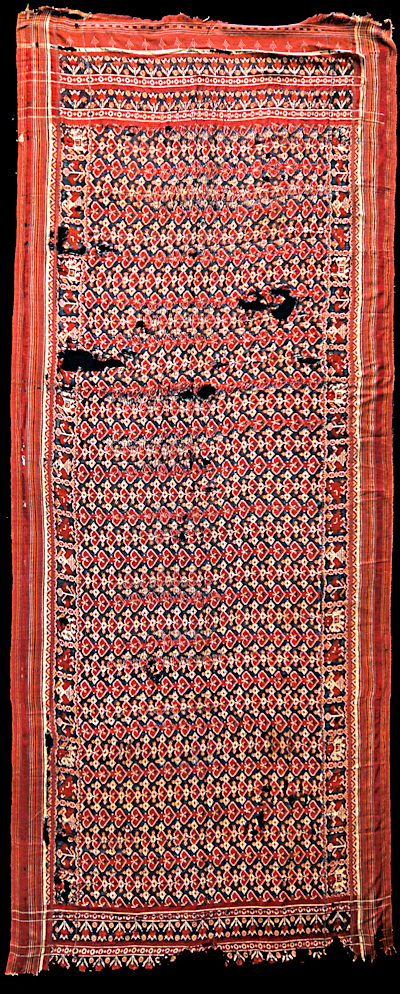| |
 
 | | | |
307 India, Gujarat
Patolu (study piece) 
| | | Period: | 18th to early 19th c. | | Yarn: | Silk, hand-spun, very fine | | Technique: | Double ikat | | Panels: | 1 | | Design: | Pan Bhat, or 'Betel Leaf Design'. The field is decorated with small pan leaves arrranged into an array. It was mainly used by Hindu and Jain Mahajans, trading casts with political influence. The border is enhanced with framed elephants, flowering plants, female dancers and parrots arranged in sequence. Patola of Bühler Type 1., bought mainly for study purposes. Note the similarity between the small figures of the dancers with their pinches waists to those seen on a Nusa Penida cloth depicted in Ten Hoopen, Ikat Textiles of the Indonesian Archipelago, p. 183, and those on Kisar ikat sarongs such as PC 102, 102, 103, etc. Direct evidence of this type of patola having influenced Indonesian ikat is found in PC 166. | | Comment: | The question is if this cloth belongs to the Indonesian cultural realm. It was found along with Indonesian cloths in an old shipping case with the Dutch owner's name stenciled on the lid - typically the type that colonials traveled with on ocean liners. This strongly supports a Dutch East Indies provenance. However, Bühler and Fischer found that all the museums' examples of Type 1 patola came from India, not Indonesia. On the other hand, they themselves mention being contradicted by an Indian author who says that this type was particularly popular in the trade with Indonesia. Then again, if it were, would we not see more frequent examples of emulation? The cloth is quite badly damaged: two large holes in the midfield, and several smaller ones. It also lost about half of the finials on one end. This matches the average condition of the Bühler and Fischer sample: nearly all the cloths in the museums they inspected were badly damaged. This patolu was acquired mainly as a study piece. This type was more influential than has so far been assumed, .e.g, on ikat design on Alor and Ternate. | | Background: | Chapters on India and Gujarat. | | Published: | Ikat from Timor and its Outer Islands, 2022.
| | Compare: | 061 062 063 338 166 | | Sources: | Bühler and Fischer, The Patola of Gujarat, Vol. 2, Plate I. | | |

©Peter ten Hoopen, 2025
All rights reserved.
|
|


